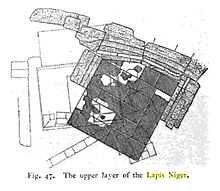
Back Lapis Niger Byelorussian Lapis Niger Catalan Lapis Niger Danish Lapis Niger German Lapis Niger Greek Lapis Niger Spanish Lapis niger Finnish Lapis niger French Lapis niger Hungarian Lapis niger Italian
 | |
| Location | Regione VIII Forum Romanum |
|---|---|
| Coordinates | 41°53′33″N 12°29′5″E / 41.89250°N 12.48472°E |
| Type | Shrine |
| History | |
| Builder | Tullus Hostilius |
| Founded | 5th century BC |

The Lapis Niger (Latin, "Black Stone") is an ancient shrine in the Roman Forum. Together with the associated Vulcanal (a sanctuary to Vulcan) it constitutes the only surviving remnants of the old Comitium, an early assembly area that preceded the Forum and is thought to derive from an archaic cult site of the 7th or 8th century BC.
The black marble paving (1st century BC) and modern concrete enclosure (early 20th century) of the Lapis Niger overlie an ancient altar and a stone block with one of the earliest known Old Latin inscriptions (c. 570–550 BC). The superstructure monument and shrine may have been built by Julius Caesar during his reorganization of the Forum and Comitium space. Alternatively, this may have been done a generation earlier by Sulla during one of his construction projects around the Curia Hostilia. The site was rediscovered and excavated from 1899 to 1905 by Italian archaeologist Giacomo Boni.
Mentioned in many ancient descriptions of the Forum dating back to the Roman Republic and the early days of the Roman Empire, the significance of the Lapis Niger shrine was obscure and mysterious to later Romans, but it was always discussed as a place of great sacredness and significance. It is constructed on top of a sacred spot consisting of much older artifacts found about 5 ft (1.5 m) below the present ground level. The name "black stone" may have originally referred to the black stone block (one of the earliest known Latin inscriptions) or it may refer to the later black marble paving at the surface. Located in the Comitium in front of the Curia Julia, this structure survived for centuries due to a combination of reverential treatment and overbuilding during the era of the early Roman Empire.
© MMXXIII Rich X Search. We shall prevail. All rights reserved. Rich X Search

